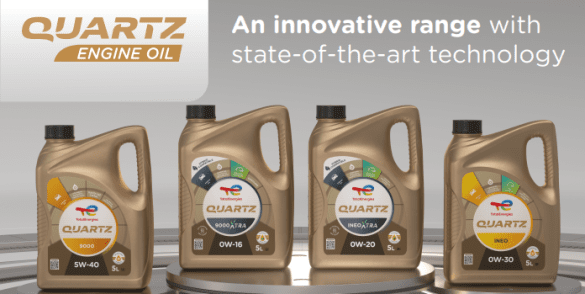There are two important factors to consider when comparing and choosing motor oils—how cold does it get in winter and what the manufacturer recommends for your engine. Ideal for starting engines at low temperatures and effective at high engine temperatures, 5w40 motor oils can be used in most conditions
WHAT DOES 5W40 ACTUALLY MEAN?
The “W” stands for “winter,” the number preceding it indicates the oil’s viscosity (or thickness) at low temperatures (hence the W), and the number after it indicates viscosity at higher temperatures (150oC on average), when the engine is actually running.
5w40 motor oil has a winter viscosity grade of five, meaning it’s less viscous at very low temperatures, compared to, say, 10w40. It has a hot viscosity grade of 40, which means it is just as viscous as 10w40 at high temperatures but less viscous than oils such as 15w50.
WHY DOES THE VISCOSITY OF MOTOR OIL MATTER?
An oil’s viscosity is its resistance to flow. Oil that’s too thick won’t flow properly through your engine. Oil that’s too thin won’t protect moving parts from wear and tear. Viscosity increases as the temperature drops and decreases as the temperature rises.
When selecting a particular grade of motor oil, you face a tradeoff between performance and protection. An oil that’s more viscous while your engine is running will do a better job of protecting engine components. But an oil that’s too thick will also be somewhat of a drag on engine performance. That’s why it’s important to consult your engine manufacturer about exactly which grade of oil is appropriate.

WHAT IS THE VISCOSITY GRADE OF AN ENGINE OIL?
The viscosity grade of an engine oil provides information on the oil’s resistance to flow in your vehicle’s engine. A lubricant with a low viscosity grade will be more fluid, more liquid, and will flow more easily. Inversely, the higher the grade, the thicker the oil, making its flow slower, which allows the formation of a protective film on engine parts.
As engine oil is affected by temperature, a grade gives information on the use and flow of the fluid when hot and when cold. An example:
- At low temperatures, it is better to choose an oil with a low viscosity grade in order to facilitate circulation of the lubricant in your vehicle during a cold engine start;
- Engine oil with a higher grade will be more resistant in the sensitive parts (hot areas) of the engine. As it is thicker, the oil will form a protective film on the engine parts, reducing wear and breakage by preventing friction between the parts.
Choosing the right viscosity grade, and therefore the right engine oil, is crucial to ensuring your vehicle runs smoothly. Oil helps cool your engine, lubricates the parts and, as we explained above, avoids friction and damage to the engine. In addition, engine oil facilitates the removal of impurities and efficiently inhibits the formation of corrosion and rust.
WHAT ARE THE DIFFERENT VISCOSITY GRADES OF AN ENGINE OIL?
How do I know what the right viscosity grade is for my vehicle? The Society of Automotive Engineers (SAE) has developed a system for classifying oils according to their viscosity grade at low and high temperatures.
Monograde oils
Monograde oils are used over a relatively small temperature range. They are generally designed for older vehicles. This type of oil breaks down into two categories that depend on the season when you will be using your vehicle.
For winter use, choose an oil with the letter “W”, which stands for Winter. These are SAE 0W, 5W, 10W, 15W, 20W and 25W engine oils. Their viscosity grade is low, meaning they are particularly fluid lubricants. Each category is defined by its viscosity at a given temperature (from -10°C to -35°C depending on the grade). When cold, the more fluid the lubricant, the less work required by the oil pump at start-up. To drive in the summer season and to take care of your engine, it is best to choose an engine oil with a high viscosity grade that is not marked “W”, meaning SAE 8, 12, 16, 20, 30, 40, 50 or 60 engine oils.
Multigrade oils
Multigrade oils are the most popular oils today because they are perfectly suited to current vehicle models. They also have the advantage of being usable in all seasons, regardless of the outside temperature. Multigrade oils are less affected by temperature variations than monograde oils. That’s why multigrade oil containers have a number on either side of the “W”. For example, on the most frequently purchased engine oils, you’ll see values such as 5W30, 15W40, or 10W40.
What do these viscosity grades mean? As with monograde oils, the “W” still means “Winter”. The number before the W represents the winter viscosity grade. In other words, the engine’s capacity to start, even at low temperatures. The smaller the number, the easier it is for the engine to start cold. As we have seen, for a fast start-up, you should choose a fluid oil.
The value after the W represents the engine oil viscosity grade at high temperatures. A high grade means optimized protection and sealing for your engine and its components, because a thick layer of oil is formed in the engine’s critical areas (hot areas). However, a less high grade will be more effective in reducing friction between hot parts and allows fuel savings.
If you have the slightest doubt when choosing the viscosity grade of your engine oil, check the automotive manufacturer’s recommendations, your vehicle owner’s handbook, or get the advice of a professional.











